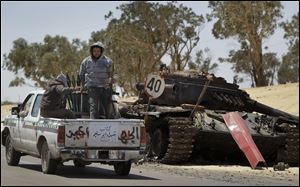
Rebels struggle to hold back Liyban offensive on front-line city
4/10/2011
Rebel fighters armed with rocket propelled grenade launchers head back into Ajdabiya, past a previously destroyed pro-Gadhafi forces tank.
AJDABIYA, Libya — Heavy fighting raged for a second day around a key front-line city Sunday as rebels struggled to keep control of a buffer zone protecting their main eastern strongholds.
Shelling and gunfire was heard across Ajdabiya after forces loyal to Libyan leader launched their most sustained offensive since being driven back by international airstrikes last month. A hospital chief said at least 13 people have been killed since fighting erupted Saturday and a Libyan official claimed government forces downed two U.S.-built helicopters used by rebels.
Rebels are desperate to hang onto the city to give breathing room to their main political base in Benghazi, about 100 miles farther up the coastal highway. If it moves into government hands, however, there is just open desert to Benghazi — the same scenario that galvanized the international air campaign over fears of mass civilian casualties.
At least 11 people died in Saturday’s fighting, said Ajdabiya hospital supervisor Mohammed Idris, with two more rebels killed Sunday.
The apparent surge in ground fighting could add urgency to the latest peace initiative. Envoys from the African Union plan to hold talks with Gadhafi and rebels during a two-day visit beginning Sunday.
An official from the African bloc, Khellaf Brahan, said its proposals call for an immediate cease-fire, opening channels for humanitarian aid and talks between the rebels and the government. But it’s unclear whether rebel leaders would agree to call off their attacks while Gadhafi remained in power.
In the capital Tripoli, the deputy foreign minister claimed government forces shot down two U.S.-built Chinook helicopters being used by rebel forces in the east of the country.
Khaled Kaim said the helicopters were shot down near the eastern oil facilities of Brega — a key objective of rebels — and accused NATO commanders of a double standard to allow rebel forces to operate aircraft in “clear violation” of the U.N.-backed no-fly zone over the country.
“We have a question for the allied forces — is this resolution made for the Libyan government only or everyone in Libya?” he asked.
The report could not be confirmed with the rebels, but journalists in the area did describe seeing at least one helicopter apparently fighting for the rebels in the area Saturday, though it lacked the distinctive double rotor design of Chinook and appeared to be a Russian built model.
Most aircraft used by the Libyans, whether government or rebel forces, are Russian made, however, but the Directory of World Air Forces from 2008 says Libya had 20 Chinooks, which are used primarily for transport and heavy lifting, in service.
While the Libyan government forces still possess most of the military aircraft in the country, a few were taken by the rebels when some air force units defected in the east of the country following popular uprisings against Moammar Gadhafi’s four decades of rule.
NATO, which enforces the no-fly zone said it has been has been applying it to both sides and on Saturday intercepted a rebel MiG-23 fighter jet and forced it back to the airport.
NATO forces also continue to carry out airstrikes against Gadhafi’s forces, destroying 17 tanks and damaging nine others, the alliance announced Saturday.
Rebels have criticized the NATO for not giving them sufficient battlefield support as government forces continue to push into the east.
In Cairo, a Red Cross shipment of 1,100 pounds of medicine and health care equipment left for the Libyan border to aid Libyan refugees.